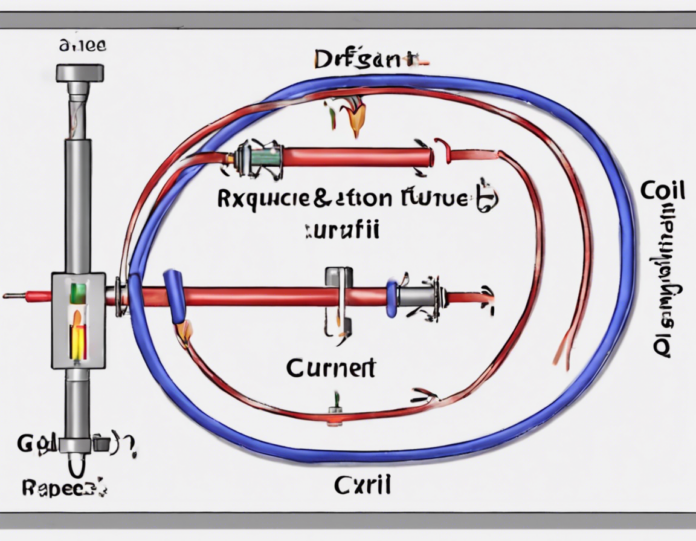In the realm of electromagnetism, the generation of an electric current in a coil can be achieved through various methods. This process of inducing current is fundamental to the operation of many devices we rely on today, such as electric generators, motors, transformers, and inductors. Understanding these methods can provide insights into the underlying principles of electromagnetism and its practical applications. In this article, we will explore the different methods of inducing current in a coil, shedding light on the diverse ways in which electromagnetic phenomena can be harnessed and manipulated.
Faraday's Law of Electromagnetic Induction
One of the primary methods of inducing current in a coil is through Faraday's Law of Electromagnetic Induction. According to Faraday's Law, a changing magnetic field through a coil of wire will induce an electromotive force (EMF) in the coil, resulting in the generation of an electric current. This phenomenon is the basis for the operation of electric generators, where mechanical energy is converted into electrical energy through the rotation of a coil in a magnetic field.
Lenz's Law
Linked to Faraday's Law is Lenz's Law, which states that the direction of the induced current will always be such that it opposes the change causing it. In practical terms, this means that the induced current will create a magnetic field that opposes the original magnetic field, leading to a self-regulating system. Lenz's Law plays a crucial role in understanding the behavior of induced currents in coils and the conservation of energy in electromagnetic systems.
Methods of Inducing Current
1. Electromagnetic Induction
The most common method of inducing current in a coil is through electromagnetic induction. This process involves varying the magnetic field passing through a coil, either by moving the coil relative to a stationary magnetic field or by changing the magnetic field itself. The relative motion between the coil and the magnetic field causes a change in flux, leading to the generation of an induced current in the coil as per Faraday's Law.
2. Self-Induction
Self-induction occurs when the changing magnetic field is produced by the current flowing through the same coil. As the current in the coil increases or decreases, it generates a magnetic field that induces an EMF in the coil itself, opposing the change in current. Self-induction is a key factor in the behavior of inductors, where energy is stored in the magnetic field surrounding the coil.
3. Mutual Induction
In mutual induction, the changing magnetic field is produced by a separate coil, which induces an EMF in another nearby coil. This phenomenon is the basis for the operation of transformers, where the primary coil generates a varying magnetic field that induces a current in the secondary coil. Mutual induction allows for the efficient transfer of energy between coils without direct electrical connection.
Applications of Induced Current
1. Electric Generators
Electric generators utilize the principle of electromagnetic induction to convert mechanical energy into electrical energy. By rotating a coil of wire within a magnetic field, an induced current is generated, producing the electricity we use in our daily lives. Generators form the backbone of power generation systems worldwide, providing electricity for industries, homes, and infrastructure.
2. Induction Motors
Induction motors rely on induced currents in coils to produce rotational motion. When an alternating current is passed through the stator coils of the motor, it generates a rotating magnetic field that induces currents in the rotor coils, causing the rotor to turn. Induction motors are widely used in various applications, from industrial machinery to household appliances.
3. Inductors
Inductors are passive electronic components that store energy in the form of a magnetic field when a current passes through them. The induced current in the coil creates a magnetic field that resists changes in the current, leading to features such as impedance and energy storage. Inductors are essential in circuits for filtering, energy storage, and signal processing.
Frequently Asked Questions (FAQs)
1. How does the number of turns in a coil affect induced current?
The number of turns in a coil directly affects the induced current, as a greater number of turns will result in a higher induced voltage. This relationship is described by Faraday's Law, where the induced EMF is proportional to the rate of change of magnetic flux and the number of turns in the coil.
2. Can direct current (DC) induce current in a coil?
While direct current itself does not induce current in a coil, a changing current in a nearby coil can create a changing magnetic field that induces a current in the first coil. This process, known as mutual induction, is the basis for transformers and the operation of some DC devices.
3. How does the material of the coil affect the induction of current?
The material of the coil can influence the induction of current due to its electrical properties. Conductive materials with low resistance allow for better current flow and reduced energy losses, enhancing the efficiency of electromagnetic induction.
4. What role does the frequency of the alternating current play in electromagnetic induction?
The frequency of the alternating current affects the rate at which the magnetic field changes in electromagnetic induction. Higher frequencies result in faster changes in the magnetic field, leading to increased induced currents in the coil.
5. Can electromagnetic induction occur in non-metallic materials?
While metals are commonly used in coils due to their conductivity, electromagnetic induction can also occur in non-metallic materials. However, the efficiency of induction and the magnitude of the induced current may vary depending on the material properties.
In conclusion, the methods of inducing current in a coil are foundational to our understanding of electromagnetism and play a vital role in various technologies we rely on daily. From Faraday's Law to mutual induction, these principles govern the generation of electricity, the operation of motors, and the behavior of inductors. By exploring these methods and their applications, we can appreciate the intricate interplay between magnetic fields and electrical currents that powers our modern world.


Recent comments